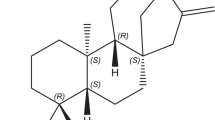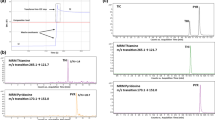Abstract
Aristolochic acids (AAs) I and II are the main bioactive ingredients in most Aristolochia plants, which are used for dietary supplements, slimming pills and Traditional Chinese Medicines (TCMs). Excessive ingestion of AAs can lead to serious nephropathy and has also been discovered to cause mutagenicity and carcinogenicity. Therefore, quantitative analysis and quality control for medicines containing AA’s are of great importance. The analysis of aristolochic acid I and II in TCM was achieved successfully in less than 5 min by capillary electrophoresis with label free intrinsic imaging (LFII) and UV detection at λ214 nm. The background electrolyte was deltaDOT’s TCM running buffer containing sodium tetraborate and β-cyclodextrin at pH 9.7. The results show very good resolution, precision and short analysis time with a detection limit of 1.23 × 10−7 and 8.83 × 10−8 mol L−1 for AAI and AAII, respectively. Comparative experiments were performed using conventional CE analysis with UV detection. The results emphasise the significant improvements achieved by the new technology. Label free intrinsic imaging is a powerful technology and can be used in the analytical arena in numerous applications including the analysis of the increasingly growing field of herbal medicine.






Similar content being viewed by others
References
Lee TY, Wu ML, Deng JF, Hwang DF (2001) J Chromatogr B 766:169. doi:10.1016/S0378-4347(01)00416-9
Vanherweghem JL (1998) J Altern Complem Med 4:9. doi:10.1089/acm.1998.4.1-9
Cosyns JP (2003) Drug Saf 26:33. doi:10.2165/00002018-200326010-00004
Fernando RC, Schmeiser HH, Scherf HR, Wiessler M (1993) IARC Sci Pub 124:167
Dong H, Suzuki N, Torres MC, Bonala RR, Johnson F, Grollman AP, Shibutani S (2006) Am Soc Pharmacol Exp Ther 34:1122
IARC Monogr Eval Carcinog Risks Hum (2002) 82:69
Wei L, Gong S, Wen D, Che B, Liao Y, Liu H, Feng X, Hu S (2004) J Chromatogr A 1049:211
Food and Drug Administration (FDA) dietary supplement: aristolochic acid, consumer advisory, April 2001. (http://www.cfsan.fda.gov/~dms/addsbot.html)
Li W, Li RK, Bo T, Liu HW, Feng XF, Hu SI (2004) Chromatographia 59:233. doi:10.1365/s10337-004-0314-9
Chan SA, Chen MJ, Liu TY, Fuh MR, Deng JF, Wu ML, Hsieh SJ (2003) Talanta 60:679. doi:10.1016/S0039-9140(03)00142-5
Lee MC, Tsao CH, Iou SC, Chuang WC, Sheu SJ (2003) J Sep Sci 26:818. doi:10.1002/jssc.200301271
Platter A, Reich E (2004) JPC-J Planar Chromatogr 17:355. doi:10.1556/JPC.17.2004.5.6
Platter A, Reich E (2004) J Liq Chromatogr RT 27:2087. doi:10.1081/JLC-120039420
Hashimoto K, Higuchi M, Makino B (1999) J Ethnopharmacol 64:185. doi:10.1016/S0378-8741(98)00123-8
Ong ES, Woo ESO (2001) Electrophoresis 22:2236. doi:10.1002/1522-2683(20017)22:11<2236::AID-ELPS2236>3.0.CO;2-T
Ma XQ, Shi Q, Duan JA, Dong TTX, Tsim KWK (2002) J Agric Food Chem 50:486. doi:10.1021/jf0202279
Ku YR, Chang YS, Wen KC, Ho LK (1993) J Chromatogr A 848:537. doi:10.1016/S0021-9673(99)00475-6
Hsieh S-C, Huang M-F, Lin B-S, Chang H-T (2006) J Chromatogr A 1105:127. doi:10.1016/j.chroma.2005.07.056
Parlow JJ, Stevens AM, Stegeman RA, Stallings WC, Kurumbail RG, South MS (2003) J Med Chem 46:4297. doi:10.1021/jm030233b
Gill AI, Frederickson M, Cleasby A, Woodhead SJ, Maria G, Carr MG, Woodhead AJ, Walker MT, Congreve MS, Devine LA, Tisi D, O’Reilly M, Seavers LCA, Davis DJ, Curry J, Antony R, Padova A, Murray CW, Carr RAE, Jhoti H (2005) J Med Chem 48:414. doi:10.1021/jm049575n
Zhou X, Zheng C, Sun J, You T (2006) J Chromatogr A 1109:152
Peng YY, Liu FH, Ye JN (2005) Electrophoresis 17:356
Zhou YX, Lei HM, Xu YH, Wei LX, Xu XF (2002) Research technology of fingerprint of Chinese traditional medicine. Press of Chemical Industry, Beijing
Acknowledgment
This work was supported by deltaDOT Ltd. London, UK.
Author information
Authors and Affiliations
Corresponding author
Rights and permissions
About this article
Cite this article
Dahab, A.A., Smith, N.W. & Marlin, N. Determination of Aristolochic Acid I and II in Traditional Chinese Medicine by HPCE with Label Free Intrinsic Imaging. Chroma 70, 467–473 (2009). https://doi.org/10.1365/s10337-009-1156-2
Received:
Revised:
Accepted:
Published:
Issue Date:
DOI: https://doi.org/10.1365/s10337-009-1156-2




